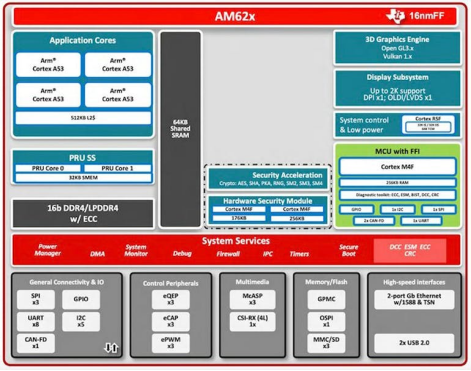We’ve been steeped in the traditional methods of human machine interface (HMI) for so long that the addition of artificial
intelligence (AI) and edge computing requires a tune-up of our knowledge base. In the past, an HMI consisted of a physical control
panel with pushbuttons, switches, trackballs, and indicator lights that enabled users to communicate with a machine. But it’s not
sacrilege to suggest that these are rapidly exiting the scene.
In their place, edge computing brings compute power to where your data is collected. Edge AI is more nimble and agile than other
forms of data processing, where data is sent to remote data centers or the cloud for processing. It offers faster, localized processing
with less latency than traditional forms of cloud computing.
With the proliferation of AI and machine learning (ML), the next generation of HMI is poised to bring entirely new ways of
interacting with machines and devices. Coupling edge AI features such as machine vision, analytics, and predictive maintenance
with HMI applications is changing the way we interact with machines. Examples include gesture and/or facial recognition in a
noisy factory environment or allowing the control of machines via digital voice assistants (such as Alexa and Siri) and a wireless
connection.
Bringing HMI to the Next Level
As HMI continues to evolve, the processor technology behind these applications must be ready to enable that evolution. Recently,
Texas Instruments released new edge AI processors aimed at HMI applications. Designed for low power, the first devices in TI’s
Sitara AM62 processor family, the AM625 and AM623, bring power-efficient edge AI processing to dual-display and small-form
applications. They include an AI accelerator that achieves high deep-learning AI inference performance. Inference involves the
process of AI analyzing data collected from a sensor and then making decisions based on it in real-time or near-real-time.
 TI put a great deal of effort into developing the AM62x family (Fig. 1). The processors consist of a quad-core 64-bit Arm Cortex-
TI put a great deal of effort into developing the AM62x family (Fig. 1). The processors consist of a quad-core 64-bit Arm Cortex-
A53 microprocessor, single-core Cortex-R5F microcontroller (MCU), and a Cortex-M4F MCU. While the AM623 targets IoT and
gateway SoCs with Arm Cortex-A53-based object and gesture recognition, the AM625 is aimed specifically at human-machine
interactions with an Arm Cortex-A53-based edge AI, and a full-HD dual-display capability.

The best part may be the low power consumption of these devices. AM62x processors achieve less than 500-mW power
consumption for a single A53 core running at 1 GHz. It’s almost half of that achieved by similar low-power and low-cost processors
in previous generations. AM62x processor power can be less than 1 W when quad A53 cores run a stressful application on all four
cores at 1.4 GHz.
To bring analytics to edge devices at low power, including suspend states as low as 7 mW with no need to design for thermal considerations, TI’s engineers employed a few clever techniques.
Low-Power Design
The low power consumption was made possible through a simplified power architecture—the device features only two dedicated
power rails and five power modes. The modular architecture of this device delivers performance with support for several low-
power modes without sacrificing critical system resources such as connectivity, power, security, safety, and cost.
Deep-sleep mode at<5 mW enables longer battery life, while an active power of <1.5 W is made possible by a core voltage of 0.75 V.
As a result, AM62 processors can reduce power consumption in industrial applications by as much as 50% compared to competing
devices, enabling an application powered by AA batteries to remain on for over 1,000 hours.
Achieving optimal power performance is further simplified with the new TPS65219, a companion power-management IC (PMIC)
specifically designed to meet AM62x processor power-supply requirements. The device is characterized across an ambient
temperature range of –40 to +105°C, making it suitable for various industrial applications. It includes three synchronous,
stepdown dc-dc converters and four linear regulators.
Additional Features
The AM62x processors include on-chip resources such as a universal asynchronous receiver/transmitter, multichannel SPI and
I2C, and various connection options for popular industrial sensors or controllers. These processors also provide dual Ethernet
support and EtherCAT master support with a third-party ecosystem.
The parts further support a wide variety of display interfaces, including the color format RGB888, where 8 bits are used for each of
the color components red, green and, blue, and a low-voltage differential signaling interface that supports 2K and full high-
definition displays. The processors support dual displays, which provide engineers with design flexibility as two screens effectively
extend the visual real estate and help to make workflow smoother.
In addition, AM62x processors support multiple operating systems, including mainline Linux and Android operating systems.
The set of peripherals included in AM62x enables system-level connectivity, such as USB, MMC/SD cards, camera interface, CAN-
FD, and GPMC (general-purpose memory controller) for parallel host interface to an external ASIC/FPGA. The AM62x device also
supports secure boot for IP protection with a built-in hardware security module (HSM) and advanced power-management support
for portable and power-sensitive applications.
The AM625 and AM623 processors come in a 13- × 13-mm, 425-pin ALW package, with pricing starting at less than $5 in 1,000-
unit quantities.The processors can meet the AEC-Q100 automotive standard in the 17.2- × 17.2-mm package (AMC). Industrial and
automotive functional-safety requirements are met when using the integrated Cortex-M4F cores and dedicated peripherals, all of
which can be isolated from the rest of the AM62x processor.